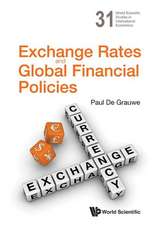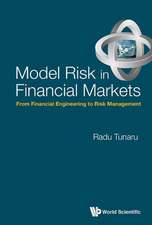Strategic Financial and Investor Communication: The Stock Price Story
Autor Ian Westbrooken Limba Engleză Paperback – 4 apr 2014
In Strategic Financial and Investor Communication: the stock price story Ian Westbrook, principal of Australia's leading independent financial communications firm, argues just this: stock price is more a story than a number. Moreover, the book will teach you how to tell your own story by guiding you through the fast-paced world of financial corporate communication with a professional's pragmatism as well as academic rigour.
Whether you're a student or a professional of PR, investor relations or corporate communications, this much-needed guide will teach you how to tell a compelling story about your company that the stockbroker, fund manager and corporate media cannot ignore.
Preț: 575.63 lei
Preț vechi: 677.22 lei
-15% Nou
Puncte Express: 863
Preț estimativ în valută:
110.14€ • 115.00$ • 91.16£
110.14€ • 115.00$ • 91.16£
Carte tipărită la comandă
Livrare economică 04-18 aprilie
Preluare comenzi: 021 569.72.76
Specificații
ISBN-13: 9780415812061
ISBN-10: 0415812062
Pagini: 306
Ilustrații: 17 black & white illustrations, 3 black & white tables, 17 black & white halftones
Dimensiuni: 189 x 246 x 23 mm
Greutate: 0.66 kg
Ediția:1
Editura: Taylor & Francis
Colecția Routledge
Locul publicării:Oxford, United Kingdom
ISBN-10: 0415812062
Pagini: 306
Ilustrații: 17 black & white illustrations, 3 black & white tables, 17 black & white halftones
Dimensiuni: 189 x 246 x 23 mm
Greutate: 0.66 kg
Ediția:1
Editura: Taylor & Francis
Colecția Routledge
Locul publicării:Oxford, United Kingdom
Public țintă
Postgraduate and UndergraduateCuprins
1. Applying Theory from Communication 2. Applying Theory from Management and Markets 3. Storytelling and Application to Corporate Communication 4. Linking Communication with Strategy, Story and Stock Price 5. Investment Perspectives on the Corporate Story 6. Numbers and the Corporate Story 7. Disclosure and Communication Content 8. The Financial Market Place 9. Communicating with the Investment Community 10. Communicating with the Business Media 11. Communicating with Shareholders 12. Transactions and Issues – M&A, IPO & Crisis 13. Role and Responsibilities of a Chief Communications Officer 14. Connecting Theory, Practice and the Corporate Story
Chapter 1: Applying theory from communication
Theory underlying financial and investor communication is not a common topic for practitioners, and yet there are many influences that can be discerned, ranging from the Ancient Greek idea of rhetoric to post-modern public relations theory. Important ideas along the way that connect with financial and investor communication are persuasion through reasoned argument, symmetric communication, the way stakeholder needs influence communication, relationships, the value of context in in enhancing understanding of corporate information and how messages are received. More recent developments of theory have explored the way in which language is a tool in competing for capital, a direct connection with investor relations.
Chapter 2: Applying theory from management and markets
A connection between communication and stock price can trace its beginnings to establishment of the world’s first stock exchange, in Amsterdam in 1602. Since then, there has been a gradual transfer of power from owners - the shareholders - to managers, with this paralleling a stakeholder relationship from a communications perspective. With early 20th century economist, Josef Schumpeter, having identified the economic importance of financial markets in channelling capital to entrepreneurs, there is a current era connection with investor relations which adopts competing for capital as a primary objective. Since stock price is a critical factor in this competition, it is important to appreciate two competing views around how information affects prices – the efficient markets hypothesis and behavioural finance. Another focus of investor relations is communicating corporate strategy, establishing a connection with Michael Porter’s five competitive forces which define strategy. While the concept of shareholder value has influenced communication in recent history, so too has modern portfolio theory, in describing decision making in investment markets. Each of these developments provides pointers to the content of financial and investor communication.
Chapter 3: Storytelling and Application to Corporate Communication
From a corporate communication perspective, narrative is a way of "interpreting the past, coping with the present and shaping the future." The effectiveness of storytelling depends on the rapport between teller and listener and storytelling can also evoke action, with parallels between how a corporation’s CEO communicates and the way this can influence stakeholders and investors. A corporate story comprising narrative, facts and numbers is not a fixed notion since, in the process of "financialization", a significant variation in the numbers can enforce a change in narrative when performance does not meet promise. There is inevitably a link between the components of story and how companies negotiate business challenges in the market place.
Chapter 4: Linking Communication with Strategy, Story and Stock Price
As management strategy has evolved from a focus on doing things right to doing the right thing, there has been a parallel realisation that corporate communication has a role in both strategic thinking and strategy implementation. This connects with the content of financial and investor communication being focused on explaining corporate strategy as well as being integrated with factors like corporate credibility, trust and reputation. There is a body of academic research which shows that communication around each of these notions has a connection with stock price. This in turn leads to a broad definition of investor relations as combining finance, communication, marketing and compliance with the law, in a process of relationship building which ultimately contributes to a company’s securities achieving a fair valuation.
Chapter 5: Investment Perspectives on the Corporate Story
An early text on security analysis argues that stock price is a legitimate concern of management. This led to establishment of the corporate function of investor relations which has evolved from an initial focus on media coverage, then swinging towards a financial focus and, in the current era, a convergence to communication. Among the influences in developing a financial and investor communications strategy are elements of marketing, although with a differing orientation to selling given the nature of stakeholders, and persuasion, contrary to Grunig’s model of corporate communication. Other influences are converting information around a company into communication, establishing "customer relationships" with the investment community and shaping corporate information to the needs of key stakeholders in developing a corporate story.
Chapter 6: Numbers and the Corporate Story
Since a lot of the content of financial and investor communication is about a company’s financial performance, it is important to have an understanding of the numbers that are used in conveying the corporate story. This chapter is intended to simplify this financial understanding, reducing a mass of information in accounting and applied finance to just five numbers and one principle, the time value of money. From this, readers will gain an understanding of a company’s three main financial statements, intrinsic value per share and an appreciation of a primary objective of investor relations, which is to reduce the cost of capital. The emphasis is on the communications aspects of financial information.
Chapter 7: Disclosure and Communication Content
The close connection between information and stock prices has led to an increasing amount of regulation around how companies communicate, in the interests of reducing market manipulation. Since there is a tension between the market wanting as much information as possible and companies preferring to manage this process, especially regarding future performance, companies have policies governing the disclosure of business and financial information. Trends in disclosure are a recognition that there are value drivers and intangibles beyond what appears in company financial statements, requiring companies to make this information available if investors are to gain a full understanding. Increasingly, regulators want companies to go beyond restating the obvious and to give reasons why certain events have taken place and how the business model works.
Chapter 8: The Financial Market Place
Appreciating the relevance of disclosure is helped by understanding how the stock market works and its key players, the sell side and the buy side. While extensive analysis is an important part of investment decision making, so too are dealing room conversations based on corporate stories that highlight industry positioning. An influence on communication with the investment community is appreciating differing investment styles, since this explains how investors focus on certain types of companies and the holding period of their investment. Institutional ownership of listed companies of 70-80 per cent makes them a key stakeholder in financial and investor communication, with programs shaped to meet their information needs in contrast to differing ways of relating to retail investors.
Chapter 9: Communicating with the Investment Community
Institutional investors and the investment community are the primary stakeholders for financial and investor communication. Research findings around communication to this stakeholder group highlight the importance of language, the influence of image restoration, the ramifications from how CEOs tell corporate stories and the overall influence of narrative. A key event for companies is announcing profit results, triggering specific communications strategies, along with other events during the year in which companies engage with existing and potential investors. Clichés of the stock market also have an effect on how listed companies communicate with the investment community, while the corporate story provides a template for encapsulating news flow and performance in comparison with expectations.
Chapter 10: Communicating with the Business Media
Successful communication with the business and financial media begins with an understanding of how this section of the media views listed companies and reports on them. Public relations sources have a significant influence on media reporting and similarly, media coverage has an influence on stock price, both positively and negatively. Successful communication with the media involves understanding writing style, what makes news and the value for journalists in having a relationship with companies. For company CEOs, there are risks in dealing with the media, with the corporate story being a guide to meeting journalists and managing good news and bad. Social media is becoming increasingly used in investor relations.
Chapter 11: Communicating with Shareholders
Shareholders, who are the owners of a listed company, are a diverse group, across institutions, individuals and employees. They also have differing motives, expectations and demands. While these differences need to be taken into account, the corporate story provides a unifying purpose for communication with shareholders. Company websites have sections devoted to this communication and the annual report is also a central document. Dealing with activist shareholders has become an increasingly important focus for communication, with activists using shareholder meetings to agitate for an influence on executive remuneration, board composition and company direction. Determining the interests of shareholders is also a factor in dealing with short sellers.
Chapter 12: Transactions and Issues – M&A, IPO & Crisis
Transactions relevant to financial and investor communication are mergers and acquisitions (M&A) and a first capital raising and listing on the stock exchange (IPO). Crisis for a listed company also has an added dimension related to dealing with the consequences of disclosure and how the stock market reacts. Statistics show that, while the majority of M&A transactions do not add value, a common ingredient in successful transactions is an effective communications program, across preparation, implementation and integration. Similarly with IPOs, a clearly articulated story has a positive effect on returns. The negative effects of crisis can be prolonged but swift implementation of a public relations plan speeds recovery. A survey of investor relations practitioners showed that their top priority in crisis is company reputation. Across all these events, it is the values contained within the corporate story that can guide communications campaigns.
Chapter 13: Role and Responsibilities of a Chief Communications Officer or IRO
A common responsibility among those in charge of listed company communication is that they are custodians of the corporate story. They are the explainers of what a company does and how it is performing financially in implementing its strategy. The role is pivotal in connecting a company with its marketplace and stakeholders. It is partly weather vane, in reporting within the corporation about the direction of winds from the market and stakeholders, and partly a producer of the information that can influence wind direction in terms of investment views about the company. The main sensitivity is mastering an understanding of the strict boundaries of disclosure. This means knowing what can be said and not said in conversations around announcements and company progress. While the majority of the focus is on aligning disclosure with communication to primary stakeholders, the role also encompasses taking the corporate story to potential investors.
Chapter 14, Connecting Theory, Practice and the Corporate Story
In his review of UK equity markets in 2012, Professor John Kay diagnosed the problem of short termism, with this caused by an exaggerated faith in the efficient markets hypothesis and undue reliance on information disclosure, much of which has little value, in response to divergences in knowledge. Disclosure has become information overload and the solution he proposes is succinct narrative reporting. This highlights the value of a crossover between theory, from communication and applied finance, and practice in investor relations. The chapter covers six aspects of this crossover – the narrative paradigm, rhetoric and persuasion, reconciling disclosure with communication, media and stock price, relationships and language as a tool in the competition for capital. This establishes a framework for the more effective practice of financial and investor communication, providing evidence for the proposition that share price is more of a story than a number.
Chapter 1: Applying theory from communication
Theory underlying financial and investor communication is not a common topic for practitioners, and yet there are many influences that can be discerned, ranging from the Ancient Greek idea of rhetoric to post-modern public relations theory. Important ideas along the way that connect with financial and investor communication are persuasion through reasoned argument, symmetric communication, the way stakeholder needs influence communication, relationships, the value of context in in enhancing understanding of corporate information and how messages are received. More recent developments of theory have explored the way in which language is a tool in competing for capital, a direct connection with investor relations.
Chapter 2: Applying theory from management and markets
A connection between communication and stock price can trace its beginnings to establishment of the world’s first stock exchange, in Amsterdam in 1602. Since then, there has been a gradual transfer of power from owners - the shareholders - to managers, with this paralleling a stakeholder relationship from a communications perspective. With early 20th century economist, Josef Schumpeter, having identified the economic importance of financial markets in channelling capital to entrepreneurs, there is a current era connection with investor relations which adopts competing for capital as a primary objective. Since stock price is a critical factor in this competition, it is important to appreciate two competing views around how information affects prices – the efficient markets hypothesis and behavioural finance. Another focus of investor relations is communicating corporate strategy, establishing a connection with Michael Porter’s five competitive forces which define strategy. While the concept of shareholder value has influenced communication in recent history, so too has modern portfolio theory, in describing decision making in investment markets. Each of these developments provides pointers to the content of financial and investor communication.
Chapter 3: Storytelling and Application to Corporate Communication
From a corporate communication perspective, narrative is a way of "interpreting the past, coping with the present and shaping the future." The effectiveness of storytelling depends on the rapport between teller and listener and storytelling can also evoke action, with parallels between how a corporation’s CEO communicates and the way this can influence stakeholders and investors. A corporate story comprising narrative, facts and numbers is not a fixed notion since, in the process of "financialization", a significant variation in the numbers can enforce a change in narrative when performance does not meet promise. There is inevitably a link between the components of story and how companies negotiate business challenges in the market place.
Chapter 4: Linking Communication with Strategy, Story and Stock Price
As management strategy has evolved from a focus on doing things right to doing the right thing, there has been a parallel realisation that corporate communication has a role in both strategic thinking and strategy implementation. This connects with the content of financial and investor communication being focused on explaining corporate strategy as well as being integrated with factors like corporate credibility, trust and reputation. There is a body of academic research which shows that communication around each of these notions has a connection with stock price. This in turn leads to a broad definition of investor relations as combining finance, communication, marketing and compliance with the law, in a process of relationship building which ultimately contributes to a company’s securities achieving a fair valuation.
Chapter 5: Investment Perspectives on the Corporate Story
An early text on security analysis argues that stock price is a legitimate concern of management. This led to establishment of the corporate function of investor relations which has evolved from an initial focus on media coverage, then swinging towards a financial focus and, in the current era, a convergence to communication. Among the influences in developing a financial and investor communications strategy are elements of marketing, although with a differing orientation to selling given the nature of stakeholders, and persuasion, contrary to Grunig’s model of corporate communication. Other influences are converting information around a company into communication, establishing "customer relationships" with the investment community and shaping corporate information to the needs of key stakeholders in developing a corporate story.
Chapter 6: Numbers and the Corporate Story
Since a lot of the content of financial and investor communication is about a company’s financial performance, it is important to have an understanding of the numbers that are used in conveying the corporate story. This chapter is intended to simplify this financial understanding, reducing a mass of information in accounting and applied finance to just five numbers and one principle, the time value of money. From this, readers will gain an understanding of a company’s three main financial statements, intrinsic value per share and an appreciation of a primary objective of investor relations, which is to reduce the cost of capital. The emphasis is on the communications aspects of financial information.
Chapter 7: Disclosure and Communication Content
The close connection between information and stock prices has led to an increasing amount of regulation around how companies communicate, in the interests of reducing market manipulation. Since there is a tension between the market wanting as much information as possible and companies preferring to manage this process, especially regarding future performance, companies have policies governing the disclosure of business and financial information. Trends in disclosure are a recognition that there are value drivers and intangibles beyond what appears in company financial statements, requiring companies to make this information available if investors are to gain a full understanding. Increasingly, regulators want companies to go beyond restating the obvious and to give reasons why certain events have taken place and how the business model works.
Chapter 8: The Financial Market Place
Appreciating the relevance of disclosure is helped by understanding how the stock market works and its key players, the sell side and the buy side. While extensive analysis is an important part of investment decision making, so too are dealing room conversations based on corporate stories that highlight industry positioning. An influence on communication with the investment community is appreciating differing investment styles, since this explains how investors focus on certain types of companies and the holding period of their investment. Institutional ownership of listed companies of 70-80 per cent makes them a key stakeholder in financial and investor communication, with programs shaped to meet their information needs in contrast to differing ways of relating to retail investors.
Chapter 9: Communicating with the Investment Community
Institutional investors and the investment community are the primary stakeholders for financial and investor communication. Research findings around communication to this stakeholder group highlight the importance of language, the influence of image restoration, the ramifications from how CEOs tell corporate stories and the overall influence of narrative. A key event for companies is announcing profit results, triggering specific communications strategies, along with other events during the year in which companies engage with existing and potential investors. Clichés of the stock market also have an effect on how listed companies communicate with the investment community, while the corporate story provides a template for encapsulating news flow and performance in comparison with expectations.
Chapter 10: Communicating with the Business Media
Successful communication with the business and financial media begins with an understanding of how this section of the media views listed companies and reports on them. Public relations sources have a significant influence on media reporting and similarly, media coverage has an influence on stock price, both positively and negatively. Successful communication with the media involves understanding writing style, what makes news and the value for journalists in having a relationship with companies. For company CEOs, there are risks in dealing with the media, with the corporate story being a guide to meeting journalists and managing good news and bad. Social media is becoming increasingly used in investor relations.
Chapter 11: Communicating with Shareholders
Shareholders, who are the owners of a listed company, are a diverse group, across institutions, individuals and employees. They also have differing motives, expectations and demands. While these differences need to be taken into account, the corporate story provides a unifying purpose for communication with shareholders. Company websites have sections devoted to this communication and the annual report is also a central document. Dealing with activist shareholders has become an increasingly important focus for communication, with activists using shareholder meetings to agitate for an influence on executive remuneration, board composition and company direction. Determining the interests of shareholders is also a factor in dealing with short sellers.
Chapter 12: Transactions and Issues – M&A, IPO & Crisis
Transactions relevant to financial and investor communication are mergers and acquisitions (M&A) and a first capital raising and listing on the stock exchange (IPO). Crisis for a listed company also has an added dimension related to dealing with the consequences of disclosure and how the stock market reacts. Statistics show that, while the majority of M&A transactions do not add value, a common ingredient in successful transactions is an effective communications program, across preparation, implementation and integration. Similarly with IPOs, a clearly articulated story has a positive effect on returns. The negative effects of crisis can be prolonged but swift implementation of a public relations plan speeds recovery. A survey of investor relations practitioners showed that their top priority in crisis is company reputation. Across all these events, it is the values contained within the corporate story that can guide communications campaigns.
Chapter 13: Role and Responsibilities of a Chief Communications Officer or IRO
A common responsibility among those in charge of listed company communication is that they are custodians of the corporate story. They are the explainers of what a company does and how it is performing financially in implementing its strategy. The role is pivotal in connecting a company with its marketplace and stakeholders. It is partly weather vane, in reporting within the corporation about the direction of winds from the market and stakeholders, and partly a producer of the information that can influence wind direction in terms of investment views about the company. The main sensitivity is mastering an understanding of the strict boundaries of disclosure. This means knowing what can be said and not said in conversations around announcements and company progress. While the majority of the focus is on aligning disclosure with communication to primary stakeholders, the role also encompasses taking the corporate story to potential investors.
Chapter 14, Connecting Theory, Practice and the Corporate Story
In his review of UK equity markets in 2012, Professor John Kay diagnosed the problem of short termism, with this caused by an exaggerated faith in the efficient markets hypothesis and undue reliance on information disclosure, much of which has little value, in response to divergences in knowledge. Disclosure has become information overload and the solution he proposes is succinct narrative reporting. This highlights the value of a crossover between theory, from communication and applied finance, and practice in investor relations. The chapter covers six aspects of this crossover – the narrative paradigm, rhetoric and persuasion, reconciling disclosure with communication, media and stock price, relationships and language as a tool in the competition for capital. This establishes a framework for the more effective practice of financial and investor communication, providing evidence for the proposition that share price is more of a story than a number.
Notă biografică
Ian Westbrook is Principal of Westbrook Financial Communications, Australia, and a part-time lecturer at the University of Sydney, having established the Financial and Investor Communication unit of study for postgraduate students in the Department of Media and Communications.
Recenzii
‘In this new work on the vital linkage between communication and stock market price Ian Westbrook challenges a number of old assumptions and provides clear evidence that the future for corporate investment lies in the vertical integration of communication throughout the firm.
It is at once a good read and a significant contribution to the theory and practice of financial communication. Mr Westbrook has taken a considered approach to the vexed issue of how, why and when CEOs should engage with stakeholders: he provides timely advice on dealing with provocateurs such as news media, citizen journalists and activist investors.
His description of 'proxy fights' in which corporations allow others, particularly media, to become leading actors is engaging while the case studies he has chosen provide a well-balanced complement to the processes and theories set out in a highly readable narrative. This book should be a 'must read' for everyone in the corporate world, or as Mr Westbrook argues, engaged in the corporate 'stakeholder' world rather than the 'shareholder' world.’ - Dr Richard Stanton, Department of Media & Communications, The University of Sydney, Australia
‘Westbrook is most instructive and current with best practice and thinking as regards navigating the capital markets. He stresses an understanding of both non-financial and basic elements of the value mosaic and is realistic in his theses, which are well resourced in academic study. Westbrook recognizes that factual information and comparative metrics only tell part of the story...colour counts. He underscores the importance of communicating with one voice and in a timely manner. This text is for the serious student of capital and value formation. Westbrook digs deep into the underlayment of the art and presents a strong case for his conclusions. This book is a standard-setter for IROs, with valuable lessons.’ - Robert D. Ferris, Chair, Capital Markets Practice, RF Binder Partners
‘This outstanding book will be a great resource for students, scholars, and practitioners as it combines solid theoretical background with very practical and current examples from the world of financial communications and investor relations.’ - Alexander V. Laskin, Ph.D., Associate Professor and Director of Graduate Studies, Department of Public Relations, Quinnipiac University, USA
‘I am delighted to say that this is a fantastic book. Not only is it the first decent, dedicated financial communications book to emerge in many years (since 1989 by my reckoning); it's also the first text to apply academic theory to financial communications in a meaningful way. I recommend it both to business and communication students alike, as well as those readers with a general interest in contemporary strategies used in financial markets.' - Clea Bourne, Lecturer, Goldsmiths, University of London, UK
‘Westbrook ends the debate on ‘art vs. science’ in the field of communications. For any corporate or investor communicator, The Stock Price Story quantifies the studies, metrics and conclusions which validate communications’ role in a company’s stock following and price. A must read for professionals in the field who need to answer to a board or the C-suite on the inherent value of communications for a public company avoid the steep costs for those who fail to tell their corporate story.’ - John Mattio, CEO & Founder of Lamnia International, a New York and Connecticut based corporate and investor communications firm focused on branding a company’s corporate story in US markets.
It is at once a good read and a significant contribution to the theory and practice of financial communication. Mr Westbrook has taken a considered approach to the vexed issue of how, why and when CEOs should engage with stakeholders: he provides timely advice on dealing with provocateurs such as news media, citizen journalists and activist investors.
His description of 'proxy fights' in which corporations allow others, particularly media, to become leading actors is engaging while the case studies he has chosen provide a well-balanced complement to the processes and theories set out in a highly readable narrative. This book should be a 'must read' for everyone in the corporate world, or as Mr Westbrook argues, engaged in the corporate 'stakeholder' world rather than the 'shareholder' world.’ - Dr Richard Stanton, Department of Media & Communications, The University of Sydney, Australia
‘Westbrook is most instructive and current with best practice and thinking as regards navigating the capital markets. He stresses an understanding of both non-financial and basic elements of the value mosaic and is realistic in his theses, which are well resourced in academic study. Westbrook recognizes that factual information and comparative metrics only tell part of the story...colour counts. He underscores the importance of communicating with one voice and in a timely manner. This text is for the serious student of capital and value formation. Westbrook digs deep into the underlayment of the art and presents a strong case for his conclusions. This book is a standard-setter for IROs, with valuable lessons.’ - Robert D. Ferris, Chair, Capital Markets Practice, RF Binder Partners
‘This outstanding book will be a great resource for students, scholars, and practitioners as it combines solid theoretical background with very practical and current examples from the world of financial communications and investor relations.’ - Alexander V. Laskin, Ph.D., Associate Professor and Director of Graduate Studies, Department of Public Relations, Quinnipiac University, USA
‘I am delighted to say that this is a fantastic book. Not only is it the first decent, dedicated financial communications book to emerge in many years (since 1989 by my reckoning); it's also the first text to apply academic theory to financial communications in a meaningful way. I recommend it both to business and communication students alike, as well as those readers with a general interest in contemporary strategies used in financial markets.' - Clea Bourne, Lecturer, Goldsmiths, University of London, UK
‘Westbrook ends the debate on ‘art vs. science’ in the field of communications. For any corporate or investor communicator, The Stock Price Story quantifies the studies, metrics and conclusions which validate communications’ role in a company’s stock following and price. A must read for professionals in the field who need to answer to a board or the C-suite on the inherent value of communications for a public company avoid the steep costs for those who fail to tell their corporate story.’ - John Mattio, CEO & Founder of Lamnia International, a New York and Connecticut based corporate and investor communications firm focused on branding a company’s corporate story in US markets.
Descriere
In today's aggressive marketplace, listed companies can no longer rely on their numbers to do the talking: communication counts. In Strategic Financial and Investor Communication: The Stock Price Story Ian Westbrook argues that share price is more a story than a number. This book will teach you how to tell your own story by guiding you through the fast-paced world of financial corporate communications with a professional's pragmatism as well as academic rigour.






















